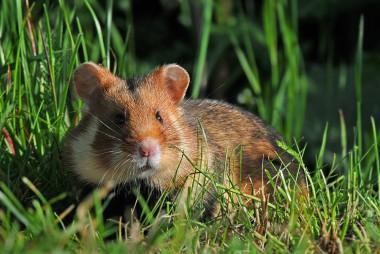Taxonomic classification
Country: | Animals (Animalia) |
Tribe: | Notochord (Chordata) |
Aub-phylum: | Verebrates (Vertebrata) |
Class: | Mammals (Mammalia) |
Subdivision: | Viviparous (Theria) |
Subdivision branch: | Placenta (Eutheria) |
Old man order: | Euarchontoglires |
Order: | Rodents (Rodentia) |
Suborder: | With a mouse complexion (Myomorpha) |
Old man family: | Muroidea |
Family: | Hamster (Cricetidae) |
Subfamily: | Hamster (Cricetinae) |
Genus: | Cricetus |
C. cricetus |
Incidence
The vulgar hamster from Flandria to West-Siberia spread. It area it’s western part it’s substance become rare, from Central Europe to the east on the other hand the vulgar rodent race of the agricultural areas. Hungary spread universally on the countries of plane, here and there expressed frequent race. It’s earliest diagnoses 300-400 thousand year, in Carpathian Basin's fauna some 200-250 thousand of the years of it’s presence continuous.
Habitat
Plane and hilly country one is a race appearing universally on the agricultural areas of landscapes. An edge, copies wandering at worst in thickets, forests with thick undergrowth occur on the open fields primarily. It’s substance density may vacillate significantly annually. It lives in subterranean cavities dug by himself. The length of the service system at which the more efferent slots are may attain the 3-4 metres; the diameter of the services 8-10 cm. It marks the neighbourhood of it’s residence with the secretion of it’s skin glands. It’s lie with vegetal stems onto soft one lines it. Winteringkamrája 1-2 metres deep can be found.
Appearance
The hamsters are rodents with a squat body. Their feet are short exceptionally. Their fur coat fundamentally yellowish-, with a reddish brown shade, their stomach coffee; their shoulder with black and white pattern. They may be found sometimes coffee ill. white copies. Their short tail sparsely fussed. The animals deliver the feed serving as the reserve in their cheek pouches, which ones hand-like one their smart forelegs empty, getting into their services.
Nourishment
A rodent with mixed nourishment, green vegetal one take parts, seed and food with an animal origin equally. In a various agricultural plant (cereal, leguminous, hemp, potato) may make harm. Carries off smaller vertebrates occasionally, eats carrion sometimes. More cases were noted when he feasted on the animals played down on the roads the hamster then into the dining belefeledkezet rodent turned into the victim of the cars it’s own. Summer collects a big amount of food in it’s subterranean depository with the help of it’s cheek pouch until an autumn being late from an end. The total weight of it’s supplies may reach the 17 kilograms. Countrymen dug up the services of the hamsters in order to be allowed to secure the seed collected by the rodent so long ago.
Habits
They like the dry, sandy soil on an extraordinary manner, into which they dig the grooves and their services,. Nocturnal animals, they stay under the land in a whole year quasi, but in case of overpopulation in daytime observable. They are saving up on whole summer (graminaceous, clover, alfalfa, tillage weeds, grain, flowers, seed, corms and tinier insects may be consumed possibly). The cold lined a period with a grass in a pantry, it is survived falling asleep. At tit’s time their body temperature cca. 4°C-ra is sinking. Some they wake up in order to take a bite out of the winter stock daily. In spring, awakes from it’s hibernation in a March, and then October is active until it’s end entirely. The hamsters live in a complicated underground service system, which is quite complex,. It’s greatness is proportional to the age of the animal directly, and the lodge of only a hamster. (where the soil allows it more hamster pantries are being made, making a false impression, that we may find a whole colony here) the animals build separate summer and winter accomodation usually. They mark their area with secretion of glands, which may stretch until 8 metre depths even,. In an average tunnel system 6-8 entrances and an emergency exit can be found. The animal may hide away easily in case of danger so. 3féle we may meet a pantry in a hamster burrow: with grass/bedchamber lined with alfalfa; larder; "latrina"( winter larder ill. accomodation)
Reproduction
The male and female individuals lonely animals. They tolerate each other's proximity in the mating period only. Tit’s begins with a late spring and reaches into the summer. At tit’s time the female two times vemhesülhet.(Áprilistól the males creep in into the services of the females, from where they are chased out after mating) annually 2 times, 4-16 kids are born following the 16 sunny pregnancies 3 times possibly it onto tit’s aim in an established nest pantry. The hamsters careful mothers, the dam stuffs the small ones into it’s cheek pouches if danger threatens the litter, you are for it’s jaw lugs them away in it’s toothless part. The natal weight of the small hamsters 7-8 g, their eyes open in their two-week age and their hair becomes richer at tit’s time. Three of their weekly ages already independently feed. Their separation happens in 3 of their monthly ages. By tit’s time already sexually mature, so the summer was born for the end of animals on the front of the year already they may have own kids.
It’s role in the soil
Than generally the soil mammals, than the mole, gopher, vole, the services of the hamster (krotovinák) important in terms of the soil, it plays a role in the vertical mixing of the substance of the soil from within on it. The breeze of the soil, a water leader's ability increase by way of it. Besides in what it plays a role yet, it the vegetal pests' destruction, yielding possibly may cause a problem in him ravaging.
http://tinyhamsters.blogspot.com/2008/11/hrcsgk-ltalnos-rendszertani-besorolsa.html
http://www.kepespolok.hu/hirek_cikkek.php?oldal=cikk_olvasasa&cikk=3283&u=1
http://tinyhamsters.blogspot.com/2008/11/kznsges-hrcsg-circetus-circetus.html
